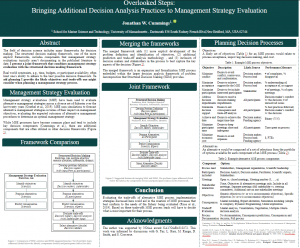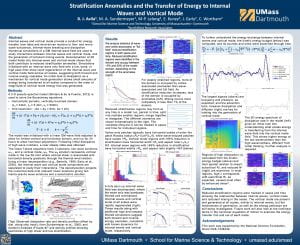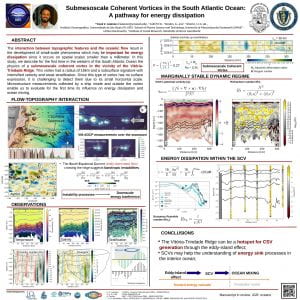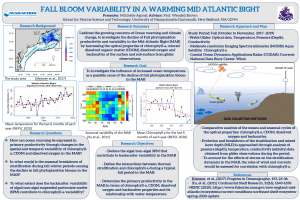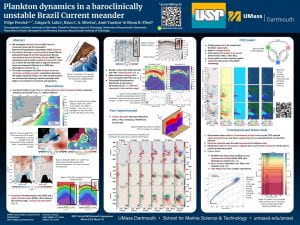Theme: Coastal Systems II
3:45 Elizabeth Ells – Dartmouth – Title: Nitrogen Removal Techniques: Unique forms of denitrification
Author(s): Elizabeth Ells, Dr. Brian Howes, and Dr. Miles Sundermeyer
As pollution increases due to population increase the need for the protection of our coastal resources is vital. For areas such as Cape Cod, with its many bays and estuaries and its predominantly residential development, the major ecological pollutant of concern is nitrogen (N) with this enrichment generating a need for N remediation. My thesis focuses on three novel N reduction approaches that stimulate denitrification and the identification of best practices that can be utilized to ensure nitrogen reduction goals are met.
I propose to analyze the potential for denitrification to be associated with living oysters, through the investigation of the shell, versus tissue, versus whole live oysters to quantify which part(s) of the oyster supports denitrifying bacteria. This effort completes a larger effort to determine the mechanisms by which oyster aquaculture can be employed as a nitrogen removal method (harvest, burial, stimulation of denitrification in the benthos). A second method of N removal I propose to look at to determine if denitrification from removable permeable reactive barriers will stimulate N attenuation in active cranberry systems. Deployment of permeable reactive barriers within this type of system is innovative and could significantly increase nitrogen removal beyond what naturally occurs. Finally, I propose to determine if N removal by macrophyte harvest will sufficiently remove enough N and P to promote long-term effects and if the epiphytic communities associated with these plants support denitrifiers. The proposed work will address unknowns regarding denitrification that will add knowledge to alternative nitrogen reduction techniques that will be vital in the coming years to meet community goals.
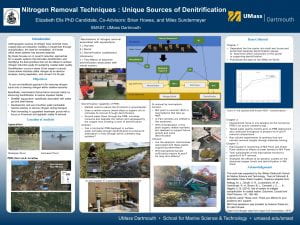
4:00 Ting Wang – Lowell – Title: Inorganic and methylated mercury dynamics in tidal water of a salt marsh estuary in Massachusetts
Author(s): Ting Wang & Daniel Obrist
Among coastal wetlands, salt marshes represent some one of the most productive and sensitive aquatic ecosystems with high species biodiversity and as such represent critical interfaces between terrestrial and oceanic ecosystems. The Plum Island Sound salt marsh estuary in Massachusetts has been reported as a hot spot of mercury (Hg) contamination – a neurotoxic global pollutant – as evident by enhanced Hg levels observed in blood of salt marsh sparrows, an important bird species endemic to salt marshes. Proposed reasons for high biological Hg exposures there include high regional atmospheric deposition, legacy Hg impacts from riverine runoff, and internal sources such as from sediment remobilization, channel erosion, and lateral tidal exchange during twice-daily tidal flooding. Additionally, a portion of inorganic Hg may be methylated to highly toxic mono-methylmercury (MeHg). However, specific Hg source inputs have not been quantified.
The objective of the study is to assess the spatial and temporal distribution of both inorganic and methylated Hg in the water column across the Plum Island Sound salt marsh estuary, in order to assess internal sources and sinks of Hg in comparison to external sources and sinks. We performed water sampling along large-scale, 25-km, transects during multiple seasons along 10 sampling locations from the ocean, through the salt-marsh dominated intertidal estuary, and to the head of the estuary at the main freshwater inlet. We applied two-endmember mixing models using freshwater and ocean water endmembers using salinity as a conservatively mixed measure. The average filtered Hg concentrations were highest in tidal water of the brackish marsh (1.31 ± 0.20 ng L-1) compared to the upstream river water (0.86 ng ± 0.17 ng L-1) and the ocean water (0.38 ± 0.10 ng L-1). Our result showed concentrations of dissolved and particulate Hg strongly enriched compared to the freshwater-saltwater mixing line, in support of a source of Hg from the saltmarsh soils to the tidal water. Our study is continuing to analyze these patterns in order to assess if the source of this Hg originates from sediments or from salt marsh soils.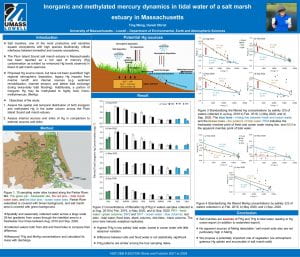
4:15 Alanna Mnich – Dartmouth – Title: Early Stages of Eastern Caribbean Cephalopods: Identification, Abundance, and Distribution
Author(s): Alanna Mnich
This study examines the density and abundance distributions as well as diel vertical migration patterns of paralarval cephalopods throughout the Eastern Caribbean, focusing on waters surrounding the US and British Virgin Islands. Spawning and survival through the paralarval stage is crucial during the short cephalopod life cycle, yet very little is known about behaviors in the paralarval stage despite significant commercial fishery interest in adult cephalopods. For this study specimens were collected in 2009 during an anomalous freshwater plume using MOCNESS and Bongo nets on the NOAA R/V Nancy Foster on a plankton-tow cruise. Cephalopods were identified to the lowest taxonomic group possible to serve as a reference source for future studies. We found highest densities at surface intervals and a diel migration pattern was observed. We were able to identify distinct cephalopod taxa as well as differentiate several more without identifications. Of these groups, it is clear that several genera dominated the total cephalopod population in the study range. We tracked specific behavioral patterns in regards to depth interval and diel distribution for the groups that were particularly prevalent and taxa known to have a strong commercial importance. We believe this study is valuable in that we accumulated a large volume of quality photographs that can serve as a reference for future identifications, as well as having contributed unique species identification and behavioral information of these understudied creatures. Given the importance of cephalopods to the commercial fishery sector, this study also provides useful information in regards to spawning and larval behavior that can lend itself to improving fisheries management practices.
3:45 Theme: Fisheries II
Olivia Aguiar – Dartmouth – Title: Variation in Market Composition and Price Between New England Seafood Markets
Author(s): Olivia K. Aguiar1, Ashleigh J. Novak1, Gavin Fay1, Katherine Masury2.
1Department of Fisheries Oceanography, School for Marine Science and Technology, University of Massachusetts Dartmouth, New Bedford MA 02744
2Eating with the Ecosystem, Wakefield RI 02880
Understanding the diversity, availability, and distribution of local New England seafood species available at marketplaces could help inform how market linkages contribute to regional seafood supply chain dynamics. Local species, some of which may be currently underused or unfamiliar to consumers, play a critical role in a sustainable regional seafood system. The RI-based non-profit, Eating with the Ecosystem, initiated a community scientist study in March 2018 and 2019 that collected information on species present at markets in New England, and recorded market type (chain, independent, or traditional), and where products were landed or originated. We used these data to determine the distribution of local seafood species across New England marketplaces and quantified price differences between market types. In 2018, 15% of the species (n=92) seen at all markets visited were labeled as local. In 2019, 40% of species (n=92) recorded were labeled as local. Independent and traditional seafood markets had a higher proportion of local species than the overall 2018 average and chain seafood markets had a similar proportion to the overall average. In 2019, there were fewer local species in chain and traditional seafood markets than average, and independent markets had a similar proportion. We found a statistically clear higher price for local seafood at traditional seafood markets over chain supermarkets in both years. These differences were also observed for specific seafood species products; chain markets had lower prices for scallops, swordfish, lobster, and tilapia. Our results provide insight into the composition of local seafood markets and where consumers may be able to find cheaper, locally harvested seafood.
4:00 Kim Sawicki – Dartmouth – Title: Subsea Buoy Retrieval Systems for Pot and Trap Fisheries
Author(s): Kim R Sawicki
Many global pot fisheries overlap with important migratory routes and habitats for whales and sea turtles. The vertical buoy lines used to mark and retrieve these gears are vulnerable to weather, tide, other vessels, and pose serious risk of entanglement to animals and other mariners. The exposure of these lines can also lead to significant gear loss & become marine debris which is a significant economic & environmental burden to fishers & coastal communities. Large whale entanglements in fishing gear are on the rise at a steady rate of 6.3 percent per year, which has led to several time area closures in important fixed gear fisheries in the United States over the last two decades. The adoption of Subsea Buoy Retrieval Systems (SBRS) or “ropeless” systems for pot fishing could remove nearly all risk related to entanglement and gear loss as the lines and buoys exist in the water column for minutes instead of hours or days. The technology accomplishes this by storing retrieval gear on the seafloor until needed and are currently being utilized for active commercial fishing and testing in several pot fisheries globally. These innovative “on demand” fishing adjuncts can provide direct benefit to fishing communities by resolving species conflict issues that affect fisher’s ability to fish how, where, and when they need.
4:15 Jonathan Cummings – Dartmouth – Title: Overlooked steps: bringing additional decision analysis practices to Management Strategy Evaluation
Author(s): Jonathan W. Cummings
The field of decision science includes many frameworks for decision making. The structured decision making framework, one of the more explicit frameworks, includes components that management strategy evaluations typically aren’t documenting in the published literature to date. I present a joint framework that combines management strategy evaluation with the structured decision making framework. Real world constraints, e.g., time, budgets, or participant availability, often limit one’s ability to adhere to the best possible decision framework. To aid planning I provide the likely objectives and trade-offs one might consider when planning a management strategy process.
Theme: Physical Oceanography II
3:45 Bailey Avila- Dartmouth – Title: Stratification Anomalies and the Transfer of Energy to Internal Waves and Vortical Mode
Author(s): B. J. Avila, M. A. Sundermeyer, M-P.Lelong, E. Kunze, J. Early, C. Wortham
Internal waves and vortical mode are ubiquitous in the ocean, providing a conduit for energy transfer from tides and wind-driven circulation to fine- and micro-scale turbulence associated with internal-wave breaking and dissipation. Numerical simulations of a Garrett-Munk internal-wave field are used to study the interactions between internal waves and vortical mode, and the generation of turbulent mixing events and semi-permanent finestructure (vortical mode). Regions of reduced stratification are found to occupy between ~5% and 25% of the model domain, depending on the strength of the anomalies. Decomposition of 3-dimensional model fields into linear internal-wave and vortical-mode components shows that both influence stratification. Time evolution of anomalies reveal coincidence with increased shear and reduced Richardson number, as well as increased Thorpe scale and dissipation rate. All are criteria for the occurrence of a mixing event and may lead to the generation of vortical mode. Simulations initialized with an internal wave only field with either a low, band, or high pass filter show rapid regeneration of the vortical mode field. An initial look into dissipation generating vortical mode energy shows a small amount of energy being transferred at all scales. A further look into the nonlinear interaction terms and the available potential energy is warranted to fully understand the energy pathways.
4:00 Caue Zirnberger Lazaneo – Dartmouth – Title: Submesoscale Coherent Vortices in the South Atlantic Ocean: A pathway for energy dissipation
Author(s):Caue Zirnberger Lazaneo, Paulo Henrique Rezende Calil, Amit Tandon, Ilson Carlos Almeida da Silveira
Mesoscale eddies propagate westward across the South Atlantic basin. As they reach the westernmost part of the basin, at approximately 20◦ S, they interact with a quasi-zonal seamount chain, the Vitoria-Trindade Ridge. This interaction leads to the formation of subsurface coherent eddies with very high levels of turbulent kinetic energy dissipation. In this study, we use high-resolution in-situ data and remote sensing to study the interaction of an anticyclonic eddy with the seamounts. We detected, for the first time in the region, a subsurface, submesoscale coherent vortex (SCV) formed as a consequence of eddy-topography interaction. The SCV had lens-shaped isopycnals within intense relative vorticity (0.35f) and low potential vorticity. The observed turbulent kinetic energy dissipation within the SCV exceeded what could be expected to waters in the interior ocean, implying the SCV drew energy from the main flow. The burst of energy dissipation occurred just below the permanent pycnocline confined to the SCV. A slightly anomalous thermohaline signature, relative to surrounding waters, suggests that the SCV was generated in the easternmost part of the ridge due to the mesoscale flow-topography interaction.
4:15 Adrienne Silver – Dartmouth – Title: Interannual and Seasonal Asymmetries in Gulf Stream Ring Formations from 1980 to 2019
Author(s): Adrienne Silver1, Avijit Gangopadhyay1, Glen Gawarkiewicz2, Nishchitha S Etige3, James Bisagni1, Mahmud Monim4, and Jenifer Clark5
1UMass Dartmouth / School for Marine Science and Technology, 2Woods Hole Oceanographic Institution, 3Boston University, 4RPS ASA – USA, 55 Village Square Drive, South Kingstown, RI 02879, 5Jenifer Clarks Gulf Stream, Dunkirk, MD, US
As the Gulf Stream separates from the coast, it sheds both Warm and Cold Core Rings between 75°W and 50°W. We present evidence that this ring formation behavior has been asymmetric over both interannual and seasonal time-scales. After a previously reported regime-shift in 2000, fifteen more Warm Core Rings have been forming yearly compared to 1980-1999. In contrast, there have been no changes in the annual formation rate of the Cold Core Rings. This increase in Warm Core Ring production leads to an excess heat transfer of 0.10 PW to the Slope Sea, amounting to 7.7-12.4% of the total Gulf Stream heat transport, or 5.4-7.3% of the global oceanic heat budget at 30°N. Seasonally, more Cold Core Rings are produced in the winter and spring and more Warm Core Rings are produced in the summer and fall leading to more summertime heat transfer to the north of the Stream. The seasonal cycle of relative ring formation numbers is strongly correlated (r=0.82) with that of the difference in upper layer temperatures between the Sargasso and Slope seas. This quantification motivates future efforts to understand the recent increasing influence of the Gulf Stream on the circulation and ecosystem in the western North Atlantic.
Theme: Physical Oceanography III
3;45 Mitchelle Agonsi – Dartmouth – Title: Fall Bloom Variability in a Warming Mid Atlantic Bight
Author(s):Mitchelle Agonsi
Advisor: Dr. Wendell Brown
I propose to investigate to what extent the increase in water temperatures is a possible cause for the decline in primary productivity during the fall-winter period in the Mid-Atlantic Bight (MAB). A review of past studies reveals a significant occurrence of a fall-winter chlorophyll maximum in the MAB. However, in recent decades, the mean chlorophyll-a concentration has decreased in the MAB. Chlorophyll-a is a complex result of the variability and breakdown of the stratification, mixed layer depth and other biological processes. The chlorophyll concentration has been measured by optical sensors on an ocean glider (called ru28) during October and November 2019. Glider ru28 also measures dissolved oxygen, colored dissolved organic matter, optical backscatter, pressure (depth), temperature and conductivity. The latter physical measurements can be used to compute salinity, density and stratification. These glider data will be used to compute along-track profiles of these variables. The spatial and temporal analysis of the inherent optical properties of chlorophyll-a fluorescence, from ru28 is conducted to investigate their roles in primary productivity. We also will employ the MODIS- aqua satellite observations to examine the large-scale surface chlorophyll-a concentrations for comparison and validation of ru28 data. The scientific findings from this research will contribute to the long-term monitoring of ocean warming and primary production in the MAB and harness the ocean observation system of glider technology.
4:00 Filipe Pereira – Dartmouth – Title: Plankton dynamics in a baroclinically unstable Brazil Current meander
Author(s): Filipe Pereira; Caique D. Luko; Ilson C. A. Silveira; Amit Tandon; Glenn R. Flierl
We investigate the Brazil Current (BC) front in a mesoscale sense and the consequent Nutrients-Phytoplankton-Zooplankton (NPZ) response. The western boundary current system off SE Brazil is formed by the poleward-flowing BC and the equatorward-flowing Intermediate Western Boundary Current (IWBC). Such dynamical scenario yields a nearly first-baroclinic-mode jet, in which BC and IWBC flow in opposite directions and can present near-zero vertically-integrated transport. The study investigates the formation of quasi-stationary mesoscale unstable meanders in this system, motivated by observations that show evidence of shelf waters’ entrainment supporting coastal planktonic communities offshore by these phenomena. We build and explore an idealized 2-layered model to understand the effect of quasi-stationary mesoscale unstable meanders in the planktonic dynamics. The shelf enriched waters are mimicked by imposing a western boundary with higher concentrations of nutrients and organisms. Further experiments with a more complex numerical model are ongoing, aiming to understand the ecological impacts of shelf water’s entrainment within these eddies and the hydrodynamic mechanisms involved.
4:15 Iury T. Simoes-Sousa – Dartmouth – Title: The mixed-layer eddies parameterization and vertical flux of biological tracers
Author(s): Iury T. Simoes-Sousa, Amit Tandon, Caue Z. Lazaneo, and Amala Mahadevan
Vertical fluxes at submesoscales are of primary importance for the vertical transport of momentum, buoyancy, and tracers. While the absence of these processes in climate models results in inconsistencies in the dynamics of the upper-ocean, it also leads to an incorrect estimation of ocean primary productivity, and hence has important implications for future climate scenarios. In this study, we couple a fully three-dimensional submesoscale-resolving model to a simple ecosystem-based model and compare it to a two-dimensional model at a coarser resolution that includes the mixed-layer eddies parameterization to determine the role of submesoscales driving the nitrate flux at the mixed-layer depth. The spring bloom production in the parameterized simulation shows a deficit of 16% as it disregards the patchy vertical flux field at the base of the mixed-layer. This process may lead to even larger cumulative differences during the nutrient-limiting regime, as in the summertime. This study highlights the importance of taking into consideration the biological implication due to the submesoscale fluxes at the base of the mixed-layer in climate models.



